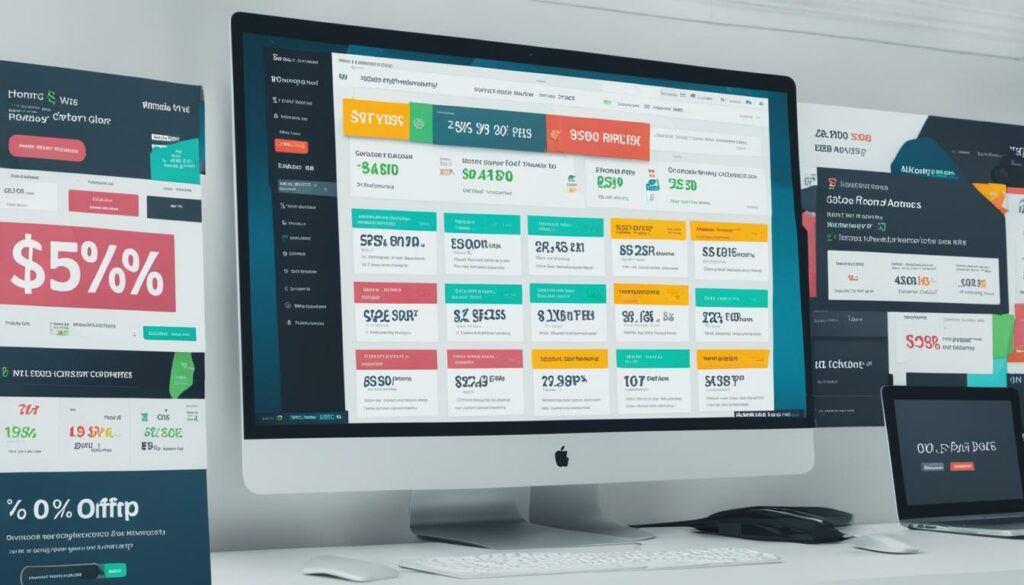WordPress is a versatile content management system (CMS) that offers powerful e-commerce solutions. By mastering the basics of WordPress and understanding essential concepts such as website monitoring, performance optimization, and security, you can unlock the full potential of your online store. In this comprehensive guide, we’ll walk you through the steps to set up and optimize your WordPress website, ensuring your e-commerce venture thrives in the digital landscape.
Key Takeaways:
- Website monitoring is crucial for ensuring optimal performance and uptime of your WordPress store.
- Regular monitoring of website analytics helps you track visitor behavior and make informed decisions for your e-commerce venture.
- WordPress security and maintenance practices are vital for safeguarding your website and protecting customer data.
- By optimizing your WordPress website for SEO and mobile responsiveness, you can attract more organic traffic and reach a wider audience.
- Enhancing your WordPress store with essential plugins can enhance functionality, improve user experience, and boost sales.
Choosing the Right WordPress Hosting Provider
One crucial factor in ensuring optimal performance for your WordPress website is choosing the right hosting provider. The hosting services you choose can significantly impact your site’s speed, reliability, and overall user experience. That’s why it’s essential to find a hosting provider that specializes in WordPress Hosting and offers top-notch features tailored to your website’s needs.
When it comes to WordPress Hosting, BoostedHost is our top recommendation. They are renowned for their exceptional hosting services that are specifically optimized for WordPress, ensuring maximum performance and reliability for your website. With BoostedHost, you can enjoy lightning-fast loading times, robust security measures, and a user-friendly interface that simplifies website management.
Here are some key features that make BoostedHost the ideal choice for your WordPress website:
- Superior Performance: BoostedHost’s optimized servers and caching mechanisms guarantee excellent speed and performance, ensuring that your visitors have a seamless browsing experience.
- Reliability: With a robust infrastructure and 99.9% uptime guarantee, BoostedHost ensures that your website is accessible to users around the clock.
- WordPress Expertise: BoostedHost’s team consists of WordPress experts who are dedicated to providing exceptional support and guidance for all your WordPress-related queries and concerns.
- Security: Protecting your website from online threats is a top priority. BoostedHost’s advanced security measures, including regular malware scans and automatic backups, offer peace of mind.
- User-Friendly Control Panel: BoostedHost’s intuitive control panel makes it easy to manage your website, install plugins, and handle other administrative tasks efficiently.
BoostedHost WordPress Hosting Plans
BoostedHost offers a range of flexible WordPress Hosting plans to suit different website needs and budgets. Here is an overview of their plans:
| Plan | Features | Price |
|---|---|---|
| Starter | 1 WordPress website, 10GB storage, 100,000 monthly visitors | $9.99/month |
| Business | 5 WordPress websites, 30GB storage, 250,000 monthly visitors | $19.99/month |
| Pro | Unlimited WordPress websites, 50GB storage, 500,000 monthly visitors | $29.99/month |
Ready to boost your website’s performance with BoostedHost’s WordPress Hosting? Sign up now through this link: www.boostedhost.com/wordpress-hosting and take your WordPress website to new heights.
Setting Up WooCommerce for Your E-commerce Store
WooCommerce is a popular WordPress plugin that offers a comprehensive solution for setting up and managing your e-commerce store. With WooCommerce, you can create a user-friendly and successful online store that caters to your e-commerce venture’s needs. Follow these essential steps to get started:
Step 1: Install the WooCommerce plugin
To begin, install the WooCommerce plugin on your WordPress website. Navigate to your WordPress dashboard and go to Plugins > Add New. Search for “WooCommerce,” click on “Install Now,” and activate the plugin.
Step 2: Configure basic settings
After installing WooCommerce, configure some basic settings to customize your online store. Set your store location, currency, and other preferences to ensure a seamless shopping experience for your customers.
Step 3: Add products to your online store
Now it’s time to populate your online store with product listings. Create detailed product pages, including images, descriptions, and pricing information, to entice customers. WooCommerce offers a user-friendly interface for managing your product catalog.
Step 4: Select suitable payment gateways
Choose payment gateways that fit your business model and provide secure transactions for your customers. WooCommerce supports various popular payment gateway integrations, ensuring a smooth and reliable payment process.
Step 5: Set up shipping options
Configure shipping options based on your business requirements. Define shipping zones, rates, and methods to provide accurate shipping costs and choices for your customers. WooCommerce offers flexibility in setting up shipping options.
By following these steps and optimizing the key features of WooCommerce, you can create a user-friendly online store that showcases your products while providing seamless payment and shipping options. Take full advantage of WooCommerce’s capabilities to build a successful e-commerce venture.

Enhancing Your WordPress Store with Essential Plugins
Enhancing the functionality of your WordPress store is crucial for success. By installing essential plugins, you can optimize your store’s performance, boost search engine visibility, improve communication with customers, and gain valuable insights through analytics tools. Here are some essential plugins that can take your WordPress store to the next level:
1. SEO Plugins
Improve your search engine visibility by optimizing your website’s content and meta tags. SEO plugins such as Yoast SEO or All in One SEO Pack provide powerful tools to help you optimize your store for better rankings in search engine results.
2. Email Marketing Integrations
Build an effective email marketing strategy by integrating your WordPress store with popular email marketing platforms like Mailchimp, Constant Contact, or ConvertKit. These plugins allow you to capture leads, send targeted email campaigns, and nurture customer relationships.
3. Analytics Tools
Gain valuable insights into your store’s performance by using analytics tools such as Google Analytics or MonsterInsights. These plugins provide detailed reports on website traffic, user behavior, conversion rates, and more, enabling you to make data-driven decisions for optimization.
Incorporating these essential plugins into your WordPress store will enhance its potential and help you create a seamless shopping experience for your customers.
Remember to choose plugins that are well-maintained, regularly updated, and compatible with your WordPress version. Keep in mind that installing too many plugins can impact your website’s performance, so be selective and only install plugins that align with your business goals.

| Plugin Name | Key Features |
|---|---|
| Yoast SEO | On-page optimization, XML sitemaps, content analysis |
| All in One SEO Pack | XML sitemaps, meta tag customization, social media integration |
| Mailchimp for WordPress | Email capture forms, automated email campaigns |
| Constant Contact Forms | Contact form creation, email list building |
| MonsterInsights | Google Analytics integration, detailed reports |
Optimizing WordPress for SEO and Mobile Responsiveness
When it comes to running a successful WordPress website, two crucial factors to consider are SEO optimization and mobile responsiveness. By prioritizing these aspects, you can improve your website’s visibility and ensure a seamless browsing experience for users on mobile devices.
Start by optimizing your content, meta tags, and images for search engines. Craft compelling and relevant content that incorporates your target keywords naturally. Use descriptive meta tags that accurately represent your pages and include relevant keywords. Additionally, optimize your images by compressing them without compromising quality and using descriptive alt tags.
Your website’s design should also be responsive and adaptable to various screen sizes, as more and more users access websites through their mobile devices. A responsive design ensures that your content is displayed correctly and that users can navigate your site easily, regardless of the device they’re using.

To achieve mobile responsiveness, consider using a responsive WordPress theme or implementing responsive design techniques. It’s essential to test your website across different devices and screen sizes to ensure optimal performance.
By focusing on SEO optimization and mobile responsiveness, you can improve your website’s performance, enhance user experience, and increase your search engine visibility. This combination will help you reach a wider audience, drive more organic traffic to your site, and ultimately boost your online presence.
WordPress Security and Maintenance Best Practices
Protecting your WordPress website from security threats is crucial. Implementing security measures is essential to safeguard your website and ensure its optimal performance. By following industry best practices, you can effectively manage your website’s security and perform regular maintenance tasks. Here are some recommended practices:
#1 Strong Passwords
Creating strong passwords is the first line of defense against unauthorized access to your WordPress website. Avoid using common passwords and include a combination of uppercase and lowercase letters, numbers, and special characters for added security.
#2 Regular Updates
Regularly updating your WordPress core, themes, and plugins is crucial to protect against known vulnerabilities and ensure compatibility with the latest security patches. Set up automatic updates whenever possible to streamline this process and reduce the risk of security breaches.
#3 Reliable Hosting Providers
Choosing a reliable hosting provider is essential for a secure website. Look for providers that prioritize WordPress security and offer features such as malware scanning, SSL certificates, and backup services. A trusted hosting provider can significantly reduce the risk of security incidents.
#4 Backup and Restore
Regularly backing up your website is crucial in case of a security breach or any other unforeseen events. Implement a backup solution that suits your needs and schedule automatic backups. Additionally, familiarize yourself with the restoration process to ensure a quick recovery if needed.
#5 Update Management
Keeping your WordPress installation, themes, and plugins up to date is essential for optimal security and performance. Regularly check for updates and test them on a staging site before implementing them on your live website to minimize compatibility issues.
By following these WordPress security best practices and performing regular maintenance tasks, you can effectively protect your website from security threats and ensure its optimal performance. Remember, proactive measures are key to maintaining the security and longevity of your WordPress store.
Advanced Customization and Design Options for WordPress
Take your WordPress store to the next level by exploring advanced customization and design options. With WordPress, you have the flexibility to create a website that perfectly aligns with your vision and brand. From custom themes to plugins, the possibilities are endless.
Creating Custom Themes
One of the best ways to give your WordPress store a unique look is by creating a custom theme. With advanced customization options, you can design a website that showcases your products and brand identity in a visually appealing way. Whether you have coding skills or not, there are plenty of resources available to help you build a custom theme that suits your needs.
“Design is not just what it looks like and feels like. Design is how it works.” – Steve Jobs
Exploring Plugin Options
Plugins are an essential part of extending the functionality of your WordPress store. There is a wide range of plugins available that can help you add advanced features and optimize your website. From SEO plugins to email marketing integrations and analytics tools, you can find the right plugins to enhance your store’s performance and meet your specific requirements.
| Benefits of Advanced Customization and Design | Create a unique and visually appealing website | Enhance user experience | Stand out from competitors | |
|---|---|---|---|---|
| Custom Themes | ✔️ | ✔️ | ✔️ | |
| Plugin Options | ✔️ | ✔️ | ✔️ |
By harnessing the power of advanced customization and design options, you can create a WordPress store that truly represents your brand and provides an exceptional user experience. With the right customization and plugin choices, your website will stand out from the competition, attract more customers, and drive conversions.
Driving Traffic to Your WordPress Store
Attracting visitors to your WordPress store is essential for generating sales. To drive traffic and increase your e-commerce venture’s success, you can implement a variety of strategies:
- Visitor Tracking: Utilize tools like Google Analytics to track and analyze visitor behavior. This data can help you understand your audience’s preferences and optimize your website accordingly.
- Search Engine Optimization (SEO): Enhance your website’s visibility on search engines by optimizing content, meta tags, and keyword usage. This ensures that your WordPress store ranks higher in relevant search results.
- Social Media Marketing: Leverage popular social media platforms to promote your products, engage with customers, and drive traffic to your website. Create compelling content and run targeted ads to reach your desired audience.
- Email Marketing: Build and maintain a mailing list of interested customers. Send personalized emails, newsletters, and promotions to nurture customer relationships and direct them back to your WordPress store.
By utilizing these strategies, you can drive targeted traffic to your WordPress store, increasing conversions, and ultimately growing your e-commerce venture. To summarize these methods, refer to the table below:
| Strategies for Driving Traffic to Your WordPress Store |
|---|
| Visitor Tracking |
| Search Engine Optimization (SEO) |
| Social Media Marketing |
| Email Marketing |
Implementing these techniques will help you reach more potential customers, increase engagement, and drive sales. Fine-tune your strategies over time based on visitor tracking data and customer feedback to further optimize your WordPress store’s performance.
Next, we’ll explore how to improve conversion rates for your WordPress store, ensuring that the traffic you drive results in successful sales.
Improving Conversion Rates for Your WordPress Store
Improving conversion rates is crucial for maximizing sales and driving the success of your WordPress store. To increase customer satisfaction and enhance conversion rates, focus on optimizing key aspects that play a significant role in the purchase decision-making process.
Product Photography: High-quality product photography can significantly impact a customer’s perception of your products. Ensure that your images are visually appealing, accurately represent your products, and showcase their features from various angles. By investing in professional product photography, you can make a positive impression and entice customers to make a purchase.
Loading Time: Website loading time is a critical factor that affects user experience. Slow-loading websites can lead to frustration and increased bounce rates, resulting in lost sales opportunities. Optimize your WordPress store’s loading time by minimizing image file sizes, leveraging caching plugins, and selecting a reliable hosting provider. A faster website will encourage customers to explore your products and complete their purchases.
Customer Service: Exceptional customer service can significantly influence conversion rates. Respond promptly to customer inquiries, provide detailed product information, and offer personalized recommendations. By creating a positive customer experience, you build trust and increase the likelihood of converting visitors into paying customers.
Cart Abandonment: Implement strategies to tackle cart abandonment, a common challenge faced by e-commerce stores. Send personalized recovery emails to remind customers of their abandoned carts and offer incentives such as discounts, free shipping, or limited-time promotions. By addressing cart abandonment, you can recover lost sales and improve your conversion rates.
To summarize, a visually appealing website with high-quality product photography, fast loading time, excellent customer service, and effective cart abandonment strategies can significantly improve your WordPress store’s conversion rates. By optimizing these vital aspects, you can attract more customers, increase sales, and achieve greater success in the competitive e-commerce landscape.
Troubleshooting and Maintenance for Your WordPress Store
Regular troubleshooting and maintenance are essential for a seamless online experience. As a website owner, it’s crucial to learn how to identify and resolve issues efficiently to ensure your WordPress store operates smoothly. By implementing effective troubleshooting and maintenance practices, you can minimize downtime, optimize performance, and provide a seamless browsing experience for your customers.
Identify and Resolve Issues Efficiently
When troubleshooting your WordPress store, it’s important to approach the process systematically. Start by identifying the specific issue you’re encountering, whether it’s a broken link, plugin conflict, or slow page load time.
- Check for any error messages or notifications that can provide insights into the problem.
- Review your website’s code and ensure it is error-free.
- Disable plugins one by one to identify any conflicts or performance bottlenecks.
- Test your website on different browsers and devices to identify any compatibility issues.
Regularly Update Plugins, Themes, and Core WordPress Files
Keeping your WordPress store up to date is crucial for maintaining optimal performance and security. Regularly update plugins, themes, and core WordPress files to access the latest features, bug fixes, and security patches. By staying updated, you can prevent compatibility issues, improve functionality, and safeguard your website against potential vulnerabilities.
Perform Routine Website Maintenance
Performing routine website maintenance tasks is essential for the long-term success of your WordPress store. Here are some key maintenance practices to incorporate into your routine:
- Regularly backup your website’s files and database to prevent data loss in case of any unforeseen issues.
- Optimize your database to improve website performance and reduce loading times.
- Clean up unused plugins and themes to declutter your WordPress installation and minimize potential security risks.
- Monitor your website’s analytics to identify any unusual activity or potential security breaches.
By implementing these routine maintenance practices, you can ensure your WordPress store remains secure, optimized, and provides a seamless online experience for your customers.
Remember, troubleshooting and maintenance are ongoing processes. Stay proactive and regularly review your website’s performance and functionality to address any issues promptly. By prioritizing troubleshooting and maintenance, you can create a robust and reliable WordPress store that delivers a seamless online experience for your customers.
Conclusion
Mastering WordPress and implementing effective e-commerce strategies are crucial steps towards achieving success in the digital landscape. With the versatile and functional nature of WordPress, combined with optimization techniques and best practices for e-commerce, you have the opportunity to elevate your online store to new heights.
One essential aspect of maximizing your WordPress website’s potential is through WordPress Monitoring. By closely monitoring the performance, security, and maintenance of your website, you can proactively identify and address any issues that may arise. This allows you to provide a seamless and secure browsing experience for your customers, ultimately contributing to the success of your e-commerce venture.
To fully harness the power of WordPress, consider enrolling in a WordPress course. By gaining the knowledge and skills needed to navigate the intricacies of the platform, you can confidently optimize your online store and make data-driven decisions that drive e-commerce success.
Embrace the possibilities that come with mastering WordPress and implementing effective e-commerce strategies. By taking advantage of WordPress Monitoring and continuously expanding your knowledge, you can unlock the full potential of your e-commerce venture and achieve remarkable success in the competitive digital landscape.
FAQ
Q: What is WordPress Monitoring?
A: WordPress Monitoring refers to the process of tracking and analyzing the performance, uptime, and security of a WordPress website. It involves using tools and services to monitor the website’s server, website speed, and other metrics to ensure optimal functionality.
Q: Why is website monitoring important?
A: Website monitoring is essential to ensure that your WordPress website is running smoothly and to identify any issues or abnormalities that may arise. It helps in detecting downtime, performance issues, and security threats, allowing you to take prompt action and prevent any negative impact on your e-commerce store.
Q: How can performance monitoring help my WordPress website?
A: Performance monitoring helps you identify any bottlenecks or issues that may be affecting the speed and overall performance of your WordPress website. It enables you to optimize your website’s performance by analyzing factors such as page load times, server response times, and resource utilization.
Q: What are the benefits of uptime monitoring?
A: Uptime monitoring ensures that your WordPress website is accessible to visitors at all times. It helps you detect and address any downtime or server issues promptly, preventing potential revenue loss and fostering a positive user experience.
Q: Why is server monitoring important for my WordPress website?
A: Server monitoring involves tracking server performance metrics such as CPU usage, memory usage, and disk space to ensure optimal server health. It helps in detecting any potential server issues or bottlenecks that could impact the performance and availability of your WordPress website.
Q: What are website analytics and how can they benefit my WordPress store?
A: Website analytics provide valuable insights into how visitors interact with your WordPress store. By analyzing data such as traffic sources, user behavior, and conversion rates, you can make data-driven decisions to optimize your website’s performance, enhance user experience, and increase sales.
Q: How can I ensure WordPress security for my e-commerce store?
A: To ensure WordPress security, it is important to implement measures such as using strong passwords, regularly updating WordPress core, themes, and plugins, using reliable hosting providers, and implementing additional security plugins or features. Regular security audits and backups are also crucial to maintain the security and integrity of your WordPress store.
Q: What are some best practices for WordPress maintenance?
A: WordPress maintenance involves tasks such as regular backups, plugin and theme updates, database optimization, spam management, and security audits. By conducting routine maintenance, you can prevent potential issues, ensure optimal performance, and enhance the overall security of your WordPress store.
Q: How can I customize and design my WordPress online store?
A: WordPress offers a wide range of customization options, allowing you to create a unique and visually appealing online store. You can customize your store’s design by using custom themes and plugins, modifying CSS and HTML, and utilizing page builders and design tools. These options give you the flexibility to tailor your store to your specific requirements and brand identity.
Q: What are some effective strategies for driving traffic to my WordPress store?
A: To drive traffic to your WordPress store, you can utilize strategies such as implementing SEO techniques to improve search engine visibility, leveraging social media marketing to engage with your target audience, utilizing email marketing campaigns to nurture leads and promote your products, and tracking visitor behavior with tools like Google Analytics to optimize your marketing efforts.
Q: How can I improve conversion rates for my WordPress store?
A: Improving conversion rates involves strategies such as optimizing your product photography to showcase your products effectively, optimizing website loading time for better user experience, providing excellent customer service to build trust and loyalty, and implementing strategies to tackle cart abandonment, such as personalized emails and retargeting campaigns.
Q: What are some troubleshooting and maintenance practices for my WordPress store?
A: Troubleshooting and maintenance practices for your WordPress store include regular plugin, theme, and core WordPress updates, monitoring website performance and resolving issues promptly, performing regular backups, and implementing security measures to protect against malware and hackers. By practicing these maintenance tasks, you can ensure a seamless online experience for your customers.
Source Links
- https://www.linkedin.com/pulse/mastering-woocommerce-step-by-step-guide-e-commerce-success-zayn-butt
- https://medium.com/@josh4853334/mastering-wordpress-a-comprehensive-guide-for-beginners-0f17b2a561bf
- https://www.elegantthemes.com/blog/tips-tricks/e-commerce-tips-for-making-your-wordpress-store-a-success












